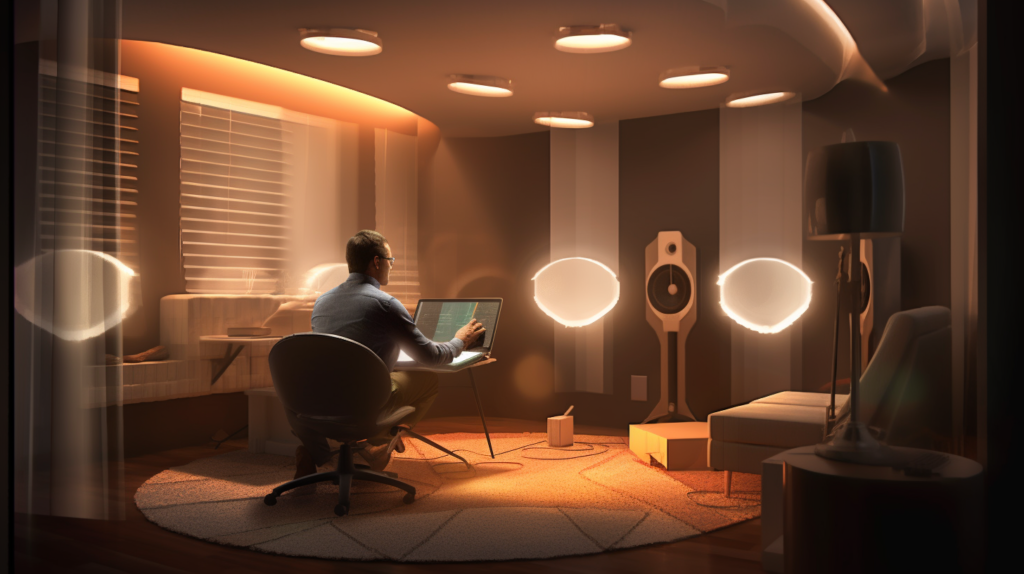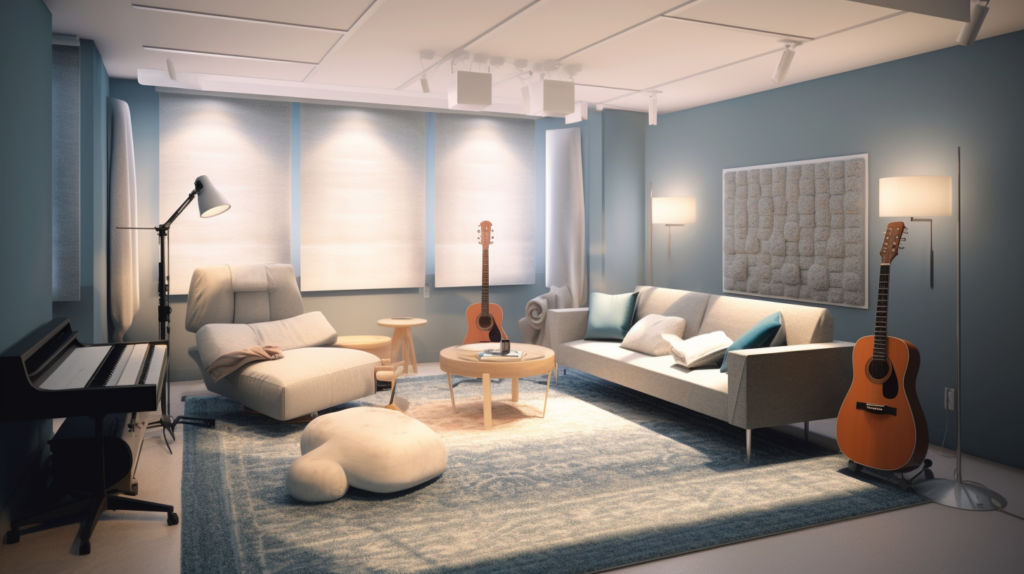Have you ever been in a room where your voice echoes or sounds muffled? Or where you can hear every footstep and conversation from the room next door?
These are common acoustic problems that make indoor spaces uncomfortable and unusable.
Poor acoustics negatively impact how we live, work, and play. But there are solutions to transform even the worst sounding rooms. With thoughtful acoustic treatment, you can dramatically enhance any space.
This guide will explore what causes problematic room acoustics and how to fix issues like echoes, excessive reverberation, and noise transfer.
You’ll learn when professional help is needed versus affordable DIY improvements you can make.
We’ll also cover specific acoustic solutions like absorption, diffusion, isolation, and subtle room layout changes.
By the end, you’ll have strategies to tailor treatments to your space and create an environment that sounds as good as it looks. Let’s dive in and unlock the secrets to better room acoustics.
What Causes Echoes and Other Noise Problems in a Room?

There are several common noise issues that can occur in residential and commercial spaces.
One is flutter echoes, which happen when sound waves bounce back and forth between parallel walls or reflective surfaces.
The echoes build up and create an unnatural reverberant sound in the room. Flutter echoes are most noticeable when clapping or speaking loudly in a space with hard, non-absorptive surfaces.
Another common problem is room resonance. This occurs when certain frequencies amplify more than others in a room due to the room’s dimensions and lack of sufficient sound absorption.
Standing waves at amplified resonant frequencies can lead to “boomy” uneven sound, especially impacting lower frequencies.
Excessive reverberation time (RT60) can also cause issues. When a room has too much reflection and not enough absorption, speech intelligibility suffers.
The sounds remain in the space for too long rather than decaying at a proper rate. High RT60 values from too much reverberation can make speech muddy and unclear.
This frequently occurs in large rooms with predominantly hard surfaces.
Finally, disruptive noise transfer between rooms is a common problem. Sounds like voices, footsteps, or music can pass through walls and floors when there is insufficient sound blocking.
Noise flanking paths like gaps around windows, doors, and penetrations enable sound transmission between rooms.
Poor sound isolation allows activities in adjacent spaces to interfere with each other.
Fixing Flutter Echoes
There are ways to address each type of noise issue using acoustic treatment methods. For flutter echoes, sound absorption is key.
Strategically placing absorptive materials on parallel walls prevents echoes from continuing to reflect back and forth.
Absorption breaks up the repetitive sound. Acoustic panels, foam tiles, drapes and wall hangings can all add useful absorption.
Diffusers also help scatter the sound rather than letting it reflect cleanly.
Bass traps are important for controlling flutter echoes and resonance in lower frequencies. Bass traps are typically thicker absorbers tuned to specifically absorb lower frequencies.
Corners are common locations for bass trap placement. The goal is to dampen the resonant amplifications causing boomy or uneven sound.
For noise transfer between rooms, increasing sound isolation is the solution. Heavier walls with insulation block airborne sound transmission more effectively.
Upgraded construction like staggered stud walls or double sheetrock improves sound blocking.
Sealing gaps and penetrations also contain sound by eliminating flanking paths. Solid core doors with perimeter gaskets can replace hollow core doors for better sound isolation.
Persistent outside noise like traffic can be covered up with pleasant masking noise like white noise or music.
Adjusting room layouts to avoid parallel walls or other focusing surfaces may also help.
For spaces requiring very precise room acoustics like recording studios, specialized solutions like non-parallel wall angles, isolated rooms within rooms, or unique geometry like elliptical rooms optimize the sound.
When Should I Hire an Acoustic Consultant?

For residential and commercial spaces with critical acoustic needs, hiring an acoustics professional is recommended.
Recording studios in particular require expert room acoustics design to achieve proper sound isolation and frequency response.
Theatres, auditoriums, conference rooms, and music venues also often warrant consultation with an acoustician.
If you need detailed acoustic measurements taken to analyze your space, an expert can perform these tests.
They have specialized equipment to measure reverberation time, background noise levels, sound isolation between rooms, and other metrics.
Typical residential or commercial rooms may not require in-depth analysis.
An acoustic consultant can also help diagnose significant acoustic defects you are unable to resolve on your own.
If flutter echoes, resonance, speech intelligibility issues, or noise transfer problems persist after your attempts to treat them, a professional assessment is a logical next step.
Proper placement and selection of acoustic treatments requires some expertise. Qualified consultants identify issues and prescribe appropriate solutions.
For specialty commercial spaces like recording studios that require world-class acoustics, hiring an acoustic designer right from the planning stage ensures the room acoustics are ideal.
Trying to retrofit an existing improperly designed space rarely achieves excellence. Factor acoustic design in from the beginning for spaces where performance is critical.
What are Affordable Ways to Improve Room Acoustics?

While major room renovations provide opportunity for ideal acoustics, upgrading existing rooms can also help. There are affordable DIY improvements requiring minimal time and investment that make noticeable differences.
Adding plush area rugs over hard flooring adds useful absorption, especially if walls and ceilings are also hard and reflective.
Sound gets trapped in the fibers instead of bouncing around the space. Rugs provide noticeable benefits for reducing excessive reverb and resonance.
Heavy drapes and curtains also absorb and diffuse sound. They are one of the easiest retrofits, just requiring mounting the curtain rods.
Tapestries, blankets, and other thick wall hangings absorb sound and reduce flutter echoes. Don’t underestimate the acoustic benefit of numerous small absorbers – every bit helps tame reflections.
Acoustic panels come in various styles to mount on walls and ceilings. Panels with sound-absorbing filling reduce excessive reverberation.
Geometric diffusing panels scatter sound in a controlled way. Basic panels are affordable and install easily with adhesive.
Panels also come in more aesthetic styles like fabric wrapped frames if appearance matters.
Adding cushions, pillows, and upholstered furniture softens up room acoustics. More sound absorbs into soft furnishings rather than causing problematic reflections.
Using carpet or area rugs on hard flooring also allows absorption. Scatter rugs can help break up open floor space.
Bookcases, cabinets, shelves, and room dividers provide diffusion as well as absorption if surfaces are uneven and items are staggered.
Plants and other decorative objects also scatter sound. The goal is to break up problematic parallel walls and open space.
Sealing air gaps around windows, doors, and penetrations containing wires or pipes is a simple upgrade. Self-adhesive foam or rubber seals, perimeter door seals, and caulking contain sound leakage.
Improved sound blocking between rooms makes activities less disruptive. Small enhancements really help control noise transfer.
With some creativity and relatively inexpensive acoustic treatment additions, it is possible to significantly enhance room acoustics on a budget.
Try a few upgrades at a time and listen for the improvements as you go. A little absorption and diffusion in the right places can make a space sound dramatically better.
Conclusion
Acoustics may seem like an obscure science, but poor room acoustics can negatively impact our daily lives.
Echoes, excessive reverb, uneven sound, and noise transfer between rooms are common issues stemming from flawed acoustic design.
Thankfully, there are solutions available both through expert consultation and affordable DIY improvements.
Strategically placed absorption, diffusion, sound isolation, and subtle room layout changes make noticeable enhancements.
Don’t tolerate problematic room acoustics that strain voices and music. Seek targeted treatments tailored to your specific issues.
With some thoughtful acoustic upgrades, you can transform the sound of your space for the better. The difference better acoustics make to quality of life indoors is well worth the effort.
